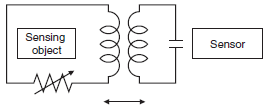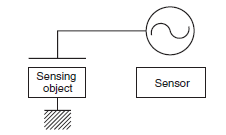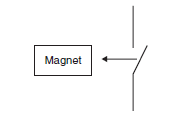Proximity Sensors
Proximity Sensors are available in models using high-frequency oscillation to detect ferrous and non-ferrous metal objects and in capacitive models to detect non-metal objects. Models are available with environment resistance, heat resistance, resistance to chemicals, and resistance to water.
| Introduction |
|
|
|
|
|
|
|
|
|
Troubleshooting |
What Is a Proximity Sensor?
"Proximity Sensor" includes all sensors that perform non-contact detection in comparison to sensors, such as limit switches, that detect objects by physically contacting them. Proximity Sensors convert information on the movement or presence of an object into an electrical signal. There are three types of detection systems that do this conversion: systems that use the eddy currents that are generated in metallic sensing objects by electromagnetic induction, systems that detect changes in electrical capacity when approaching the sensing object, and systems that use magnets and reed switches.
The Japanese Industrial Standards (JIS) define Proximity Sensors in JIS C 8201-5-2 (Low-voltage switchgear and controlgear, Part 5: Control circuit devices and switching elements, Section 2: Proximity switches), which conforms to the IEC 60947-5-2 definition of non-contact position detection switches.
JIS gives the generic name "proximity switch" to all sensors that provide non-contact detection of target objects that are close by or within the general vicinity of the sensor, and classifies them as inductive, capacitive, ultrasonic, photoelectric, magnetic, etc.
This Technical Explanation defines all inductive sensors that are used for detecting metallic objects, capacitive sensors that are used for detecting metallic or non-metallic objects, and sensors that utilize magnetic DC fields as Proximity Sensors.
Features
1. Proximity Sensors detect an object without touching it, and they therefore do not cause abrasion or damage to the object.
Devices such as limit switches detect an object by contacting it, but Proximity Sensors are able to detect the presence of the object electrically, without having to touch it.
2. No contacts are used for output, so the Sensor has a longer service life (excluding sensors that use magnets).
Proximity Sensors use semiconductor outputs, so there are no contacts to affect the service life.
3. Unlike optical detection methods, Proximity Sensors are suitable for use in locations where water or oil is used.
Detection takes place with almost no effect from dirt, oil, or water on the object being detected. Models with fluororesin cases are also available for excellent chemical resistance.
4. Proximity Sensors provide high-speed response, compared with switches that require physical contact.
For information on high-speed response, refer to Explanation of Terms.
5. Proximity Sensors can be used in a wide temperature range.
Proximity Sensors can be used in temperatures ranging from -40 to 200°C.
6. Proximity Sensors are not affected by colors.
Proximity Sensors detect the physical changes of an object, so they are almost completely unaffected by the object's surface color.
7. Unlike switches, which rely on physical contact, Proximity Sensors are affected by ambient temperatures, surrounding objects, and other Sensors.
Both Inductive and Capacitive Proximity Sensors are affected by interaction with other Sensors. Because of this, care must be taken when installing them to prevent mutual interference. (Refer to the Precautions for Correct Use in the Safety Precautions for All Proximity Sensors.)
Care must also be taken to prevent the effects of surrounding metallic objects on Inductive Proximity Sensors, and to prevent the effects of all surrounding objects on Capacitive Proximity Sensors.
8. There are Two-wire Sensors.
The power line and signal line are combined. If only the power line is wired, internal elements may be damaged.
Always insert a load. (Refer to the Precautions for Safe Use in the Safety Precautions for All Proximity Sensors.)
Operating Principles
Detection Principle of Inductive Proximity Sensors
Inductive Proximity Sensors detect magnetic loss due to eddy currents that are generated on a conductive surface by an external magnetic field. An AC magnetic field is generated on the detection coil, and changes in the impedance due to eddy currents generated on a metallic object are detected.
Other methods include Aluminum-detecting Sensors, which detect the phase component of the frequency, and All-metal Sensors, which use a working coil to detect only the changed component of the impedance. There are also Pulse-response Sensors, which generate an eddy current in pulses and detect the time change in the eddy current with the voltage induced in the coil.
(Qualitative Explanation)
The sensing object and Sensor form what appears to be a transformer-like relationship.

The transformer-like coupling condition is replaced by impedance changes due to eddy-current losses.
The impedance changes can be viewed as changes in the resistance that is inserted in series with the sensing object.
(This does not actually occur, but thinking of it this way makes it easier to understand qualitatively.)
Detection Principle of Capacitive Proximity Sensors

Capacitive Proximity Sensors detect changes in the capacitance between the sensing object and the Sensor. The amount of capacitance varies depending on the size and distance of the sensing object. An ordinary Capacitive Proximity Sensor is similar to a capacitor with two parallel plates, where the capacity of the two plates is detected. One of the plates is the object being measured (with an imaginary ground), and the other is the Sensor's sensing surface. The changes in the capacity generated between these two poles are detected.
The objects that can be detected depend on their dielectric constant, but they include resin and water in addition to metals.
Detection Principle of Magnetic Proximity Sensors

The reed end of the switch is operated by a magnet. When the reed switch is turned ON, the Sensor is turned ON.
Classification
Selection by Detection Method
| Items requiring confirmation | Inductive Proximity Sensors | Capacitive Proximity Sensors | Magnetic Proximity Sensors |
| Sensing object | Metallic objects (iron, aluminum, brass, copper, etc.) | Metallic objects, resins, liquids, powders, etc. | Magnets |
| Electrical noise | Affected by positional relationship of power lines and signal lines, grounding of cabinet, etc. CE Marking (EC Directive compliance) Sensor covering material (metal, resin). Easily affected by noise when the cable is long. | Almost no effect. | |
| Power supply | DC, AC, AC/DC, DC with no polarity, etc. Connection method, power supply voltage. | ||
| Current consumption | Depends on the power supply, i.e., DC 2-wire models, DC 3-wire models, AC, etc. DC 2-wire models are effective for suppressing current consumption. | ||
| Sensing distance | The sensing distance must be selected by considering the effects of factors such as the temperature, the sensing object, surrounding objects, and the mounting distance between Sensors. Refer to the set distance in the catalog specifications to determine the proper distance. When high precision sensing is required, use a Separate Amplifier model. | ||
| Ambientv environment | Temperature or humidity, or existence of water, oils, chemicals etc. Confirm that the degree of protection (refer to the Degree of Protection) matches the ambient environme | ||
| Physical vibration, shock | An extra margin must be provided in the sensing distance when selecting Sensors for use in environments subject tovibration and shock. To prevent Sensors from vibrating loose, refer to the catalog values for tightening torque during assembly. | ||
| Assembly | Effects of tightening torque, Sensor size, number of wiring steps, cable length, distance between Sensors, surrounding objects. Check the effects of surrounding metallic and other objects, and the specifications for the mutual interference between Sensors. | ||